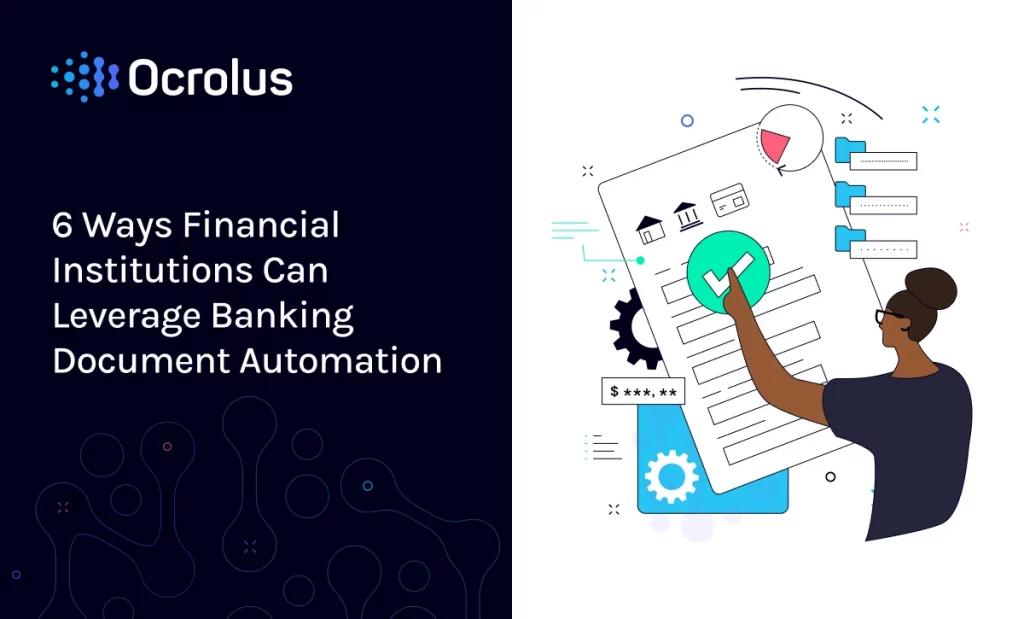6 Ways Financial Institutions Can Leverage Banking Document Automation

The quest for better efficiency and higher margins is fueling demand for fintech automation. According to the Ocrolus 2022 Market Map, key trends include the increasing use of artificial intelligence (AI) by fintechs and continued interest in fraud detection technology.
Financial institutions are embracing the move from manual document review to automated workflows that facilitate lending for lenders and borrowers. Speed and accuracy are mission-critical for digital lending. Ocrolus is designed to help financial services make high-quality decisions with trusted data and unprecedented speed. Banking document automation solutions such as Ocrolus enable financial institutions to approve loans faster and more accurately. Here are six key strategies that fintechs can use to optimize their workflow automation processes:
Six strategies for expediting the lending process using automation
1. Eliminate manual review
Eliminating manual review of documents helps to speed bank data processing and to ensure data accuracy. Automation reduces errors and improves the quality of the information that underwriters receive from loan processors. For example, Ocrolus can help accelerate the bank statement verification process by automatically extracting data from bank statements with high accuracy and providing robust cash flow analysis—facilitating faster decision-making.
2. Standardize communication
Poor communication is an example of how human error can adversely impact the lending process. The traditional approach to loan processing relies on a tedious and time-consuming process that requires repetitive manual work and cumbersome communication steps, both internally and between a financial institution and its customers.
Standardization streamlines communication and facilitates the exchange of data between lenders and consumers within institutions. Document processing automation depends on unambiguous and machine-friendly data for accurate lending decisions. Moreover, centralized communications related to each borrower facilitate financial institution review and auditing.
3. Provide electronic documents
Manual printing, scanning, and faxing of documents slows down the processing and approval time for loan applications. By contrast, digital collaboration eliminates the need for these and other cumbersome manual processes. Digital document-driven workflows also reduce the volume of additional paper processing and review at each step in the lending process.
Optical Character Recognition (OCR) is a key component in the automation process. Ocrolus technology intelligently selects the extraction or OCR tool that produces the most accurate results. Data fields that cannot be automatically confirmed are processed using a combination of machine and human review.
4. Automate workflows
Automation is the key to a more seamless digital workflow, streamlining everything from processing loan documents to getting approval signatures electronically. Machine learning technology enables information from paper documents to be contextualized and structured into data that can expedite lending decisions. Ocrolus processes every document with high accuracy thanks to Human-in-the-Loop technology that benefits from machine learning for processing and human experts for validation.
5. Track document and loan status
Automation is the engine needed for implementing workflow management solutions that enable financial institutions to manage and share documents from an online repository. Business process management technology automates the entire loan application workflow, from document collection to approval. The ability to automatically index and organize documents and data makes managing documents and loan status faster and easier. Ocrolus Detect, for example, uses machine learning technology to help financial institutions identify potentially fraudulent loan documents. This financial document fraud detection solution uses algorithms that leverage a dataset of more than 100 million pages of documents from thousands of financial institutions. The result is a highly accurate automated fraud detection solution.

6. Aid in compliance
In addition to detecting fraud, financial institutions need to ensure compliance with government regulations. Many fintechs are required to comply with regulatory requirements that cover everything from fair lending and non-discrimination to privacy and data protection.
Automating compliance saves fintechs time and money managing workflows, including documenting credit decisions, documentation processing, and loan due diligence. Automated Know Your Customer (KYC) processes also facilitate risk management and provide an audit trail for aiding in tax, licensing, accounting, and legal regulatory compliance.
How leading financial institutions use document automation
Two financial institutions that successfully use banking document automation to improve accuracy and efficiency are Kapitus and Excelerate Capital.
Kapitus: The fintech — both a direct lender and a marketplace with a network of financing partners — replaced its manual data entry system with an automated solution developed by Ocrolus. As a result, Kapitus can use machine learning to extract and analyze data, facilitating everything from document automation to fraud detection. In addition to eliminating manual data entry and review, the automated system provides Kapitus with an end-to-end loan processing and underwriting solution.
Excelerate Capital: The full-service mortgage lender implemented an Ocrolus automation solution to expedite document processing and review. In addition to faster processing, automation enables Excelerate to go beyond a borrower’s credit score when making lending decisions. Access to reliable data from borrower documents allows the company the ability to consider more than just traditional credit scores when reviewing a mortgage application. Automation has reduced underwriting review times from two hours to 30 minutes. Ultimately, automating the review of millions of pages of loan documentation each year will enable Excelerate Capital to more easily scale its loan processing capabilities to meet consumer demand.
Automated document processing for banking and financial institutions
Intelligent document processing is a must-have for fintechs. According to McKinsey, using AI in global banking can deliver as much as $1 trillion in additional value annually. In this AI-powered digital age, automation technology means more than better efficiency and lower costs; it translates into lower risk and better human decision-making.
Connect with one of our automation experts to find out how Ocrolus can help you verify banking documents using automation.




